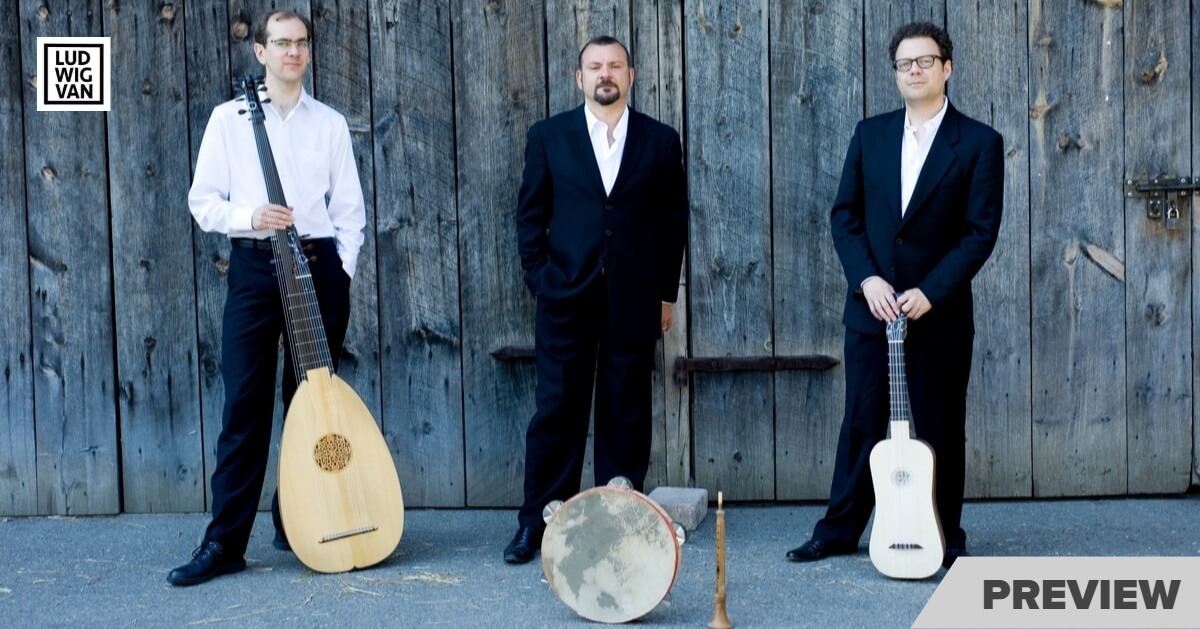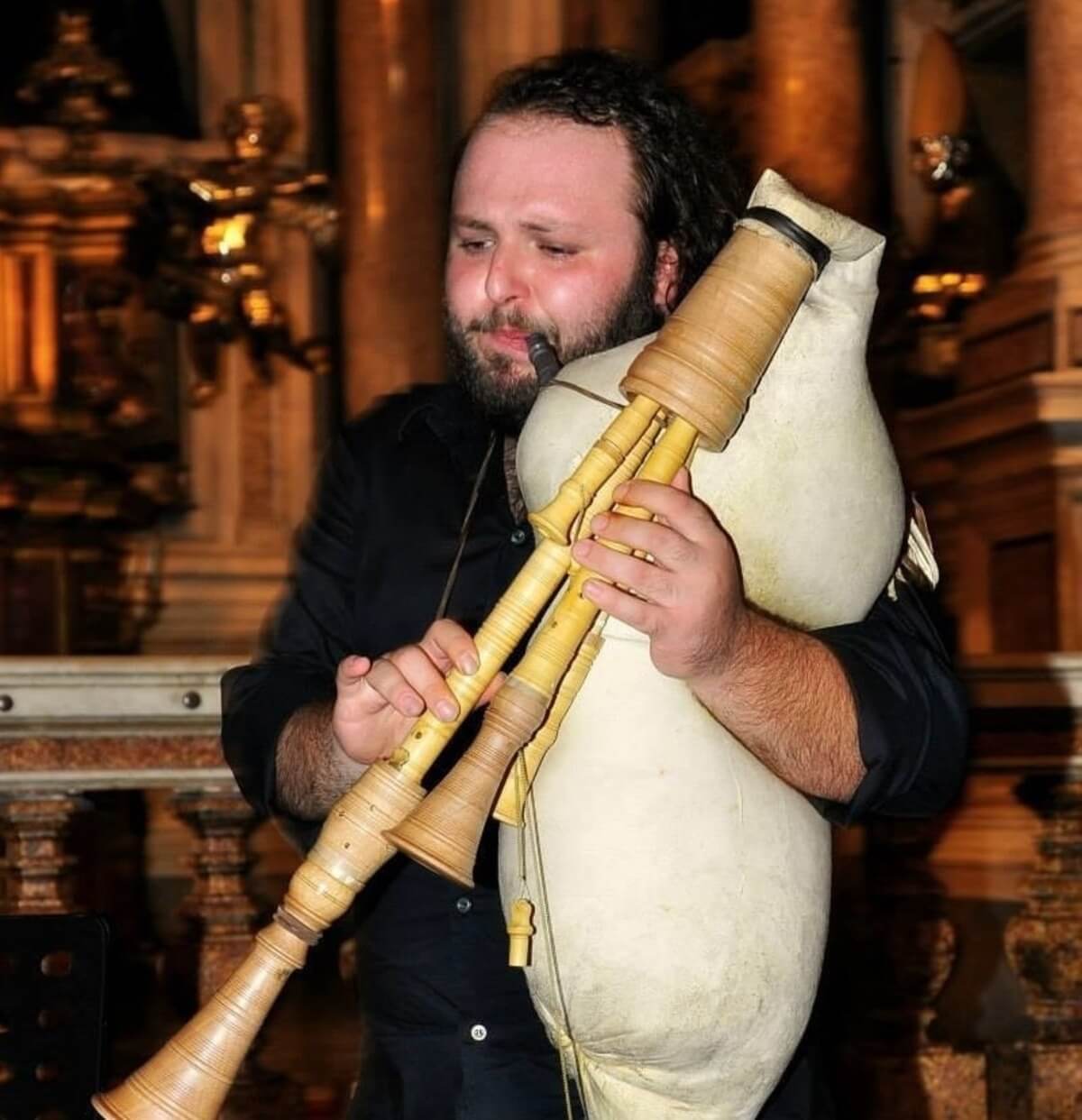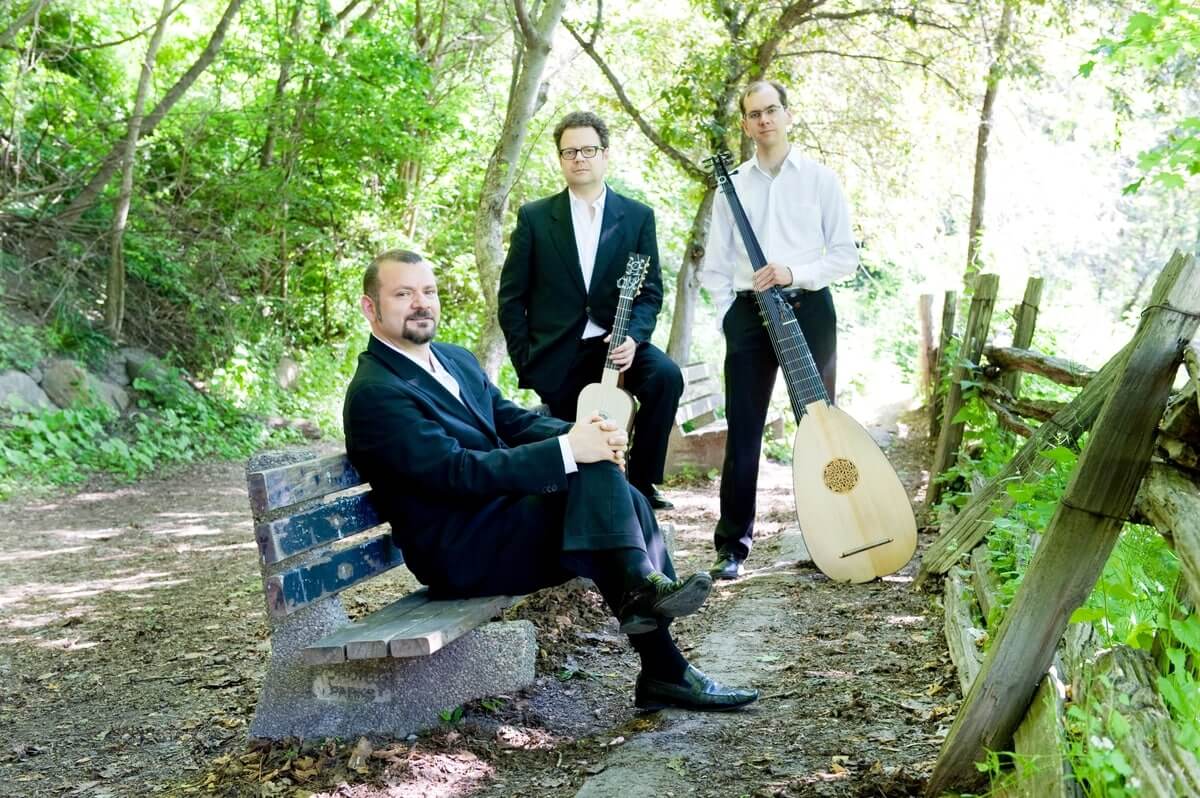Tommaso Sollazzo, Marco Cera, Francesco Pellegrino, and Lucas Harris talk about zampognari and other Southern Italian traditions that go into the Tafelmusik/Vesuvius Ensemble’s upcoming O Come Shepherds concert.

Whether it is Mariah Carey belting out “I don’t care about the presents,” or the familiar Coke polar bears animation, or a Messiah performance, or even eggnog, we share many common symbols that signify the Christmas Holiday season. In fact, Christmas-tide has conquered the world, and we are bombarded from the very minute past Halloween. It is difficult, sometimes, even to tell whether one is resonating or simply resigned to the Christmas-Holiday spirit. And then there is O Come Shepherds.
This Tafelmusik–Vesuvius Ensemble collaboration presents two genres — familiar Christmas Baroque favourites and a fresh chapter based on the zampogna and transumanza, of sheep and shepherds, from the traditional agrarian life of Southern Italy.
Every winter, shepherds move their flocks from the mountains to lower pastures (and vice versa for the summer), a journey that lasts about four days, covering over 200 km on foot. The journey is full of people, livestock, food and music, and the zampogna —Italian bagpipes, handmade using local wood and sheep/goat skin — remain a strong centre of this folk culture.
Though this ancient tradition may not be known outside of Italy, the contemporary zampognari are still a living part of Southern Italian rural communities, as they travel from door to door, church to church; even now, every church in Southern Italy procures zampognari for services for two novenas: Immaculate Conception (December 1-8), and the Arrival of the Christ Child (December 16-24). Considered the custodians of the music that was heard at Christ’s birth, zampognari may play at weddings and other religious festivals, but their biggest role is for Christmas. Next week, special guest Tommaso Sollazzo, will be filling the hall with his zampogna with friends from Tafelmusik and the Vesuvius Ensemble.

“I would have never imagined a couple of years ago, that I would have had the honour of bringing the culture of my country around the world,” Tommaso says. “My music is deeply rooted in the ancient Greek world, and it is a miracle that it was handed down from one generation to the next right up to today. The Novena di Natale is for sure a very evocative tune. Where I come from, it is played during the liturgy of Christmas Eve and there is no one who is not touched when listening to it.”
Coming from a musical family, Tommaso remembers building a toy zampgona with a plastic bag and pens. He studied classical guitar, and is a great multi-instrumentalist, but it was only with the zampogna that he fell in love straight away. “I approached the zampogna, thanks to old players who, during Christmas, used to walk around from house to house to play the Novena. I became friends with some of them who taught me the secrets and rules of zampogna playing,” says Tommaso. For him, zampogna isn’t just an instrument, but a way of life, resonating across history and present:
“The waning moon during the winter months is the time to harvest cane, which after at least five years of seasoning, will serve for making reeds,” he explains. “The spring is the time for tanning hides, while the summer is perfect for the carving and tuning reeds. The autumn is the best time for cutting wood that will serve to make new instruments. All of these secrets have been passed down from father to son. Every family had its own way of tuning the instrument, its own methods of carving reeds, and its own repertoire of music… it truly is a philosophy for living.”
Marco Cera of both Vesuvius and Tafelmusik, grew up on the other side of Italy — in the north — and he remembers seeing a zampognari busker for the first time in the 1980s in a town near Vicenza. As per tradition, the zamponari would’ve been doing his round all over Italy during Christmas time, and Marco was immediately taken by it. “I remember chasing the two zampognari and asking them to show me the instruments,” says Marco. “I was totally fascinated by the sound and the look of those instruments and I decided to buy a ciaramella.”
Ciaramella, also called piffero and pipita, exists in many local versions, and this double-reed instrument is the traditional partner to the zampogna; the ciaramella player usually plays or sings the melody. Marco’s experience as an oboe player was certainly useful, but as this was pre-YouTube, he had to try his best in person to learn the style: “There is a fantastic zampogna festival in Scapoli near Isernia, held every summer on the last weekend of July. This charming little town gets crowded with zampognari and bagpipe players from all over the world. A perfect occasion to learn some licks!”
Marco dug deeper into the Neopolitan style while playing in the Cappella Della Pietà Dei Turchini, and when he met Tommaso, Marco felt that he finally had the opportunity to learn directly from the tradition. And behold, one day, Marco realized that this shepherd music is very close to his heart, literally. “I did my research and found out that my family, the Ceras, originated in the northern mountains of Italy, near the plateau of Asiago, famous for its cheese. I realized that the early members of the Cera family must have been for sure all shepherds! I’m sure I have shepherd blood in my veins.”

The ancient songs, the novenas, that Tommaso learned from traditional players of the Cilento region, are Marcos’ favourites from the program, and he is thrilled to share it. “It is something very unique and rare. I hope that they will enjoy the juxtaposition of traditional sounds with the sound of pastorals written by baroque composers. These composers were inspired and fascinated by the zampognari as much as we are nowadays.”
Francesco Pellegrino of Vesuvius Ensemble started singing traditional Neopolitan music since he was just a little kid, and for him, to sing the music that he grew up with to a fresh audience in Toronto, is always a joy. “I grew up in a period, that of the 70s (in Italy), when thousands of radio stations broadcast all the Neapolitan music and novenas all day. Quanno nascede ninno is heard during the Christmas period in Italy still today, as it was in the past,” says Francesco (we’ll hear it in O Come, Shepherds).
Moving to Canada in 2001, Francesco brought much to contribute to Toronto, especially with his expertise in traditional Neapolitan music. Since their formation, VE has amassed a dedicated following, and when Francesco sees other ensembles creating programs with Tarantelle or Villanelle alla Napolitana, or when there’s a new inquiry in his inbox about where to buy a tammorra or a battente guitar, he is quite excited.
“The wonder of Italy is that it is a small country, but that every single region from north to south is a microcosm in the cosmos, and the thing that unites it in this total difference between them is precisely the popular music that is made by farmers, workers et cetera, because the texts as subjects are the same. So, long live the popular music that unites!” Francesco says.
Lucas Harris got heavily into Italian folk music as Vesuvius Ensemble was being formed, and being a plucked-instrumentalist, it was never far from his studies. “Right away, there were strong connections with the 16th and 17th century composed music I have studied, especially in the vocal style which is so full of improvisation and sprezzatura — a term difficult to translate but is sometimes rendered as nonchalance — as well as the use of bassi ostinato: repeating bass lines or chord progressions,” says Lucas.
For this concert, among many new instruments for the audience, Lucas and Tommaso will play the chitarra battente, a kind of rustic version of the Baroque guitar, the strings being made of metal rather than gut. “I like to point out that the plucked stringed instruments have an intimate connection with the tarantella; the word pizzicare in Italian has many meanings including: to bite, to pinch, and to pluck. So you use this same word to talk about a player plucking a string as well as the famous bite of a spider (a bite victim is called a pizzicato/pizzicata),” says Lucas.
One of three chitarra battentes available to Vesuvius Ensemble was made by Pasquale Scala. It was purchased for the ensemble by John Caliendo, who remembers his first Vesuvius Ensemble experience vividly. “I had attended a Vesuvius Ensemble concert at Trinity St. Paul’s United Church some four years ago and was so moved by the performance that I approached Francesco and offered to help in any way I could,” said John. John currently supports the Vesuvius Ensemble through concert series sponsorship, though he himself is not a musician, and hence has not played the instrument himself. “I get to see the instruments at Vesuvius concerts, but I dare not touch them,” he says.
Lucas was integral in creating this program, and he believes that these concerts will be amazing.“The experience of hearing this music should be both spiritual and earthy at the same time…and in a way this high/low paradox really defines the Christmas story; it’s the divine Messiah being born among the shepherds in the countryside. The zampognari, though humble shepherds, are considered to be the custodians of the very music that was heard at Christ’s birth. And this concert will unpack how that music came to be embedded in so much Baroque Christmas music.”
December always feels like it’ll burst at any moment. There are people to go see, events to attend, drinks to pour and much noise making. The nights are long, and the lights stay on late. How different it must’ve been, for the workers who met the birth of King of kings, to be in the fields, in that quiet, star-filled night. Instead of all the glitz and powerful stereos pumping international professional quality beats, how must it have been, when the local folks filled their village with their humble homemade instruments, raising their own voices to mark the holiday?
Come and find out. We talk incessantly of consumerism/anti-consumerism. Sustainable living. Environmental awareness. It will all be there, in the fabric of this program. Come and meet the simpler world, as it visits us next week.
O Come Shepherds, Tafelmusik and Vesuvius Ensemble, with special guest Tommaso Sollazzo. December 4 to 8, and 10. Details here.
[Update: A previous version stated Francesco Pellegrino moved to Canada in 2007 when it was 2001.]
#LUDWIGVAN
Want more updates on classical music and opera news and reviews? Follow us on Facebook, Instagram or Twitter for all the latest.
- CRITIC’S PICKS | Classical Music Events You Absolutely Need To See This Week: April 22 – April 28 - April 22, 2024
- CRITIC’S PICKS | Classical Music Events You Absolutely Need To See This Week: April 15 – April 21 - April 15, 2024
- SCRUTINY | Laurie Anderson Entrances A Sold-Out Koerner Hall With A Journey Down The Rabbit Hole - April 8, 2024



